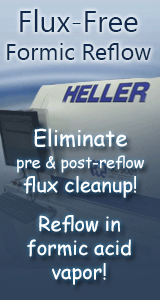IPC-HDBK-001 w/Amendment 1 Handbook and Guide to Supplement J-STD-001 (Includes J-STD-001B to C Comparison). During fabrication and storage, both components and PWBs will often absorb water. If left in the device, this water will vaporize at soldering temperatures and can lead to PWB delamination, soldering voids (especially in PTHs), and device cracking. For PWBs, the bakeout removes water accumulated during the fabrication process and absorbed during storage. Recommended baking times and temperatures 2 are given in Table 7-1. Longer bakeout times and higher temperatures are not recommended, as they can degrade PWB and component solderability. Water re-absorption begins immediately upon removal of the PWB from the oven and is linearly related to RH. For a storage environment of 20�C and 30% RH, a maximum interval of two to three days is recommended with the interval decreasing with increasing humidity . Plastic encapsulated devices, especially ICs, also have a tendency to absorb water from the air, which is violently released during soldering. Typically, 1000 ppm of absorbed moisture is considered a maximum content beyond which device failure due to body cracking may result. Bakeouts similar to those used for PWBs have been successful in eliminating these defects. After baking, the parts again begin to absorb water. Recommended maximum storage times after bakeout as a function of RH at 25�C 4 are given in Table 7-2, based on the time to achieve 800 ppm of water (see 5.0.9). Table 7-1 Baking Times and Temperatures Baking Temperature*C||Baking Time [Hour] 120||3.5 to 7 100||8 to 16 80||18 to 48 Table 7-2 Maximum Storage Times After Bakeout Relative Humidity %||Maximum Recommended Storage Time [Day] 36||20 40||11 50||7
IPC-FA-251 recommends 121*C for 30-60 minutes for 1 and 2 flex layer circuits. A rigid flex can take easily an hour per layer depending on the construction. The more layers the longer the time. 140*C is above the rating of acrylic adhesives and could possibly damage the bond.
reply »
![]() Hi ,
i desire to find the type of information :
Wh...
- Nov 21, 2008
by
saintete1304
Hi ,
i desire to find the type of information :
Wh...
- Nov 21, 2008
by
saintete1304
![]()
![]()
![]() IPC-HDBK-001 w/Amendment 1 Handbook and Guide to Supplement ...
- Nov 22, 2008
by
davef
IPC-HDBK-001 w/Amendment 1 Handbook and Guide to Supplement ...
- Nov 22, 2008
by
davef
![]()
![]()
![]() Thanks ,
Have you a table more complet than the Table 7-2...
- Nov 24, 2008
by
saintete1304
Thanks ,
Have you a table more complet than the Table 7-2...
- Nov 24, 2008
by
saintete1304
![]()
![]()
![]() No, but we find discussions about relative humidity fairly s...
- Nov 24, 2008
by
davef
No, but we find discussions about relative humidity fairly s...
- Nov 24, 2008
by
davef
![]()







